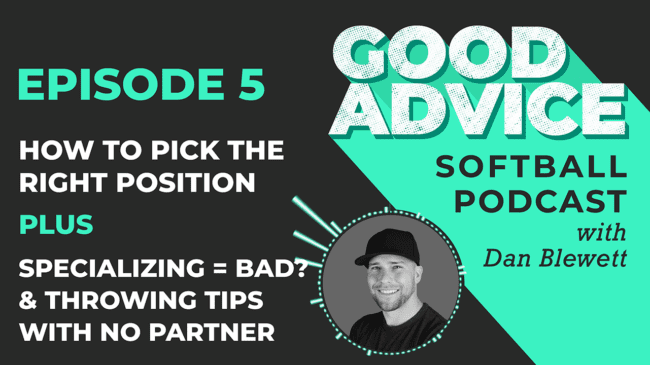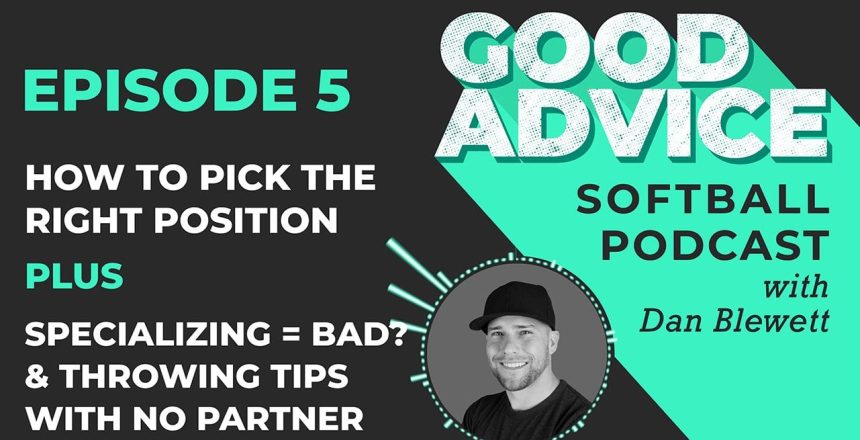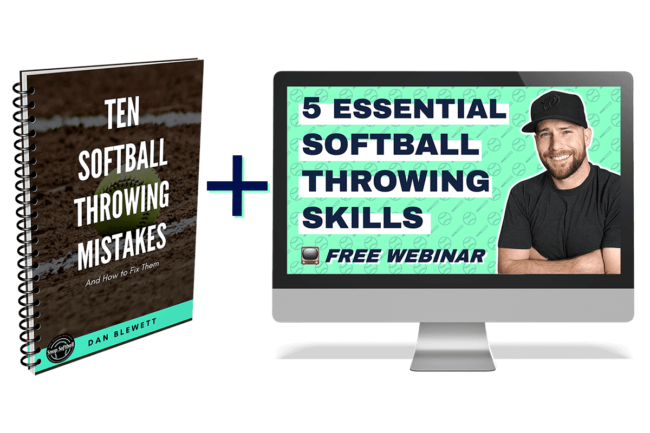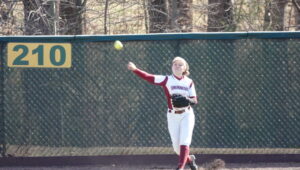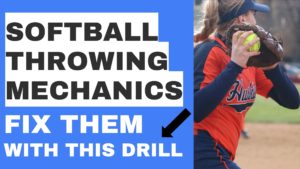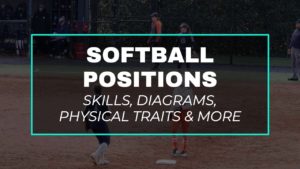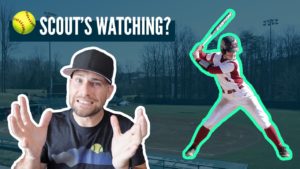*This article may contain product links which pay me a small commission if you make a purchase. Learn more.
In episode five, coach Dan talks about how to pick the right position for a softball player to have a fighting chance at playing in college. Being a utility player can be good, but also potentially ruinous. Being a specialist in the wrong position can be a death sentence to college fastpitch dreams. Dan also discusses specializing in softball–is being a multi-sport athlete good or bad? Lastly, the question of the day involved how to keep your throwing arm in shape without a partner.
Podcast: Play in new window | Download
Subscribe: Apple Podcasts | Spotify
To submit a question for the Good Questions Q&A segment, make a voice recording and email it to Dan at hello@danblewett.com.
Want to support the show? Enroll in one of Coach Dan’s online throwing courses or his mental skills course. Use code GOODADVICE to save 20% on any course, just for being a listener.
Sign up for Dan’s Email list and get his free throwing eBook, and follow up with him on the interwebs: YouTube Channel | Twitter | Snapsoftball.com
Full Transcript: EP5 Good Advice Softball Podcast: Picking the Right Position to Get Recruited; Specializing in Softball = Bad? Throwing Tips without a Partner
You are listening to the good advice, softball podcast. I’m Dan Blewett. And on this show, you’ll learn how to help the softball player in your life. Sharpen her skills, improve her mindset and find new confidence through softball.
Hey, welcome back. I’m Dan Blewett. This is the good advice, softball podcast. Today’s topic. Let’s talk about what position do you play and why? So let me share a story from my Academy from a couple of years back. We had a player. She was a pretty tall, I’d say she’s probably five, nine, and a really athletic.
And she had an absolute cannon for an arm. She threw like 65, 67 across the diamonds, or just missiles across the diamond. And if you don’t have a good frame of reference for velocity, I went to a 14. You try out one year, took my radar gun, got radar of all like 50 or 60 players. And the average for 14, you was like 47 to 52.
Actually, I think this was a 16 new trial. It’s been a while, but it was, uh, at the very least eighth grade. And maybe there were some high school players there. So around 50 miles per hour is pretty normal for a 14 year old or a 15 year old. And this girl at 15, uh, was throwing around 60, 62. And then by the time she was a sophomore junior, she was throwing up to like 65, 67, which is really, really hard.
And so she’s like pretty athletic, like pretty tall, so she could fill out. I mean, if you’re five, nine, you know, that’s pretty tall for a female athlete and you also have a big frame where you could put on some real muscle, you have some long levers, like you could be a really powerful athlete as you fill out.
And so she had a lot of tools where she probably started to profile. As you start to look at, you know, the athletes that are selected for their positions, she’d start to profile for. Like corner outfield or potentially corner infield, but more like third base. So. This is important to know as a parent, because you need to figure out where your daughter fits in on the field.
And this can be a really bad problem, essentially getting them on the wrong track. So what I mean by this is the following lots of players. Uh, they, they get on, they start to play a position when they’re younger, because there’s maybe a need on the team, or maybe it’s the only position that they can really play.
So two examples of where they hide, and this is not all about throwing, but. Two places on the field where they, where you hide a bad arm or second base. Cause it’s a very short throw or first base. Cause you don’t have to make that many throws in general. So lots of times. Players with the weakest arm, but who still have other good qualities?
Like maybe they’re good fielders or they’re really good hitters. Coaches will hide them at second base or first base. Because again, they’re not very throwing intensive positions players that have to have really good arms include all the outfield positions, but, but most importantly, right field, because that’s such a long throw to third base, uh, and.
Shortstop and third base, cause those are also longer throws across the diamond and obviously catchers to have a good chance of catching bass. Dealers need to have a good arm as well. Every arm, uh, is important on the field, but if, obviously, if you don’t have a player with a premium arm, it makes sense to put them at first base or second base.
However, here’s the caveats. Lots of times a player will play first base because she’s young and has, has a poor arm. But she’s not going to have enough power to be there longterm because when you go to look at a college roster or even a good varsity teams roster, because the first baseman doesn’t have to be an incredible fielder, they don’t have to be having incredible arm.
They really do need to have a lot of power in that position. And a bigger body makes a bigger target, so bigger players to really play, to play for space. And you can see this. In college softball, you can see this in, in division one, baseball division, two baseball, any level of baseball, any level of softball.
And of course in the major leagues, the biggest slowest power hitters play first base because the base you can, where you can put the biggest body without them really hurting their defensive abilities, their range, all that stuff, right? It’s a small little section of the field they have to cover, but lots of times players because of their arm or other things, they play first base at a young age.
But they can’t really project there. They’re not really gonna have the power to be there long term. So maybe it’s a player is like kind of tall, but really skinny. And she’s playing first base when she’s young, but she’s just not gonna have the pop to play there in college. If a college scout comes and watches her, she’s going to say she doesn’t have the power to play first base at our level.
Whereas that player might have the ability to play the college level. She plays say the outfield. Or say like third base, something like that. So you’d what you don’t want to do is type cast your daughter or players on your team into the wrong position too early. Because again, if they come out and watch you, and they’ve only seen you play first base, but they already say like, Hey, she doesn’t fit the mold of a first baseman.
Now they haven’t seen her play any other position where she could maybe shine. And that’s a major problem. So back to this, this player that I was talking about, she had a cannon, she was tall and athletic, but she wasn’t quite athletic enough to play shortstop at the, at the collegiate level. She’s like, didn’t have quite the good enough glove and not quite good enough range.
Uh, but she had a good glove and she had decent range. So the best infielder on the field is obviously gonna be the shortstop. They have to have incredible hands. They have to have incredible range and they have to have a very good arm. Um, and so the, the most premium infielders is gonna play short, but, and because of how important of a defensive position that is, you can be a lesser hitter and play short because we value defense more than we value your bat.
And so if you have a bigger bat, Um, you become a better candidate to play third. And this is also a place where, Hey, if you can really hit a lot and maybe you’re not an amazing defender, we can put you at third because we need you in the lineup. And we already have a first baseman who’s big and strong.
So the next like power position after the first basement is typically the third basement or one of the coroner outfielders cause corner Outfitters don’t have to go as far to catch flyballs center. Centerfielder has the biggest range they have to cover. And so the four power positions, typical in the field, or first base, third base corner outfield left field, right field.
And so as a parent, as a player, you need to understand this because if you, if you say I’m a third baseman, but you’re kind of little and you don’t have a big bat. And you don’t have a big arm. You’re not really a third basement, or if you’re an amazing defender, but you just don’t have much of a bat at all.
You’re also probably not a college third basement, and you’re probably a college second basement cause of college. Second basement is an also amazing defender with not that big of a bat and not that big of an arm. That’s what a second basement looks like. So this is, again, this is important to know because there, the following, the following implications are important.
You’re as a, as a softball player, you need to find out what positions you could actually profile to play in college. So if you’re really big and powerful, you could play first base, maybe third base. And if you’re not fast, if you’re like one of those big powerful, but kind of slow players, you’re not going to be, to play the outfield.
You’re just going to be quick enough. You’re certainly not going to play the middle infield. So you’re really going to be stuck at first third, or maybe catcher if you’re a catcher, but obviously catchers are very specialized. If you have a ton of speed, you could play an infield position. They probably wouldn’t put you on a corner field position.
Cause it’d be wasting that speed. Or you could play the outfield. If you have an incredible arm, they could put you anywhere. Um, and then they’re really going to have to see where else you fit if you have an incredible arm, but you can’t run down a fly ball way into the gap. They’re going to put you on a corner outfield position or third base so they can get use out of your arm.
And again, corner outfield. You just need to have decent range and decent fielding ability, but not be an amazing. Outfielder. So the problem can be again, if a player is stubborn and she says, no, I want to play third base. Well, it’s like, ah, I don’t think you’re going to be good enough to play third base in college.
We really need to get you some reps in the outfield because that might be your way to get in there. And they say, no, then that’s their prerogative, but it could be the wrong track to be stuck on. Where someone says, ah, you know, this player, I, I see her a third, you’ve got a great arm, but she’s just not that good of a third basement or whatever.
And, you know, we need an outfielder, but she doesn’t play outfield. So same thing could be true for an outfielder who just loves playing the alpha, but maybe they’re not good enough. Or maybe they don’t have a big enough bat to play corner outfield. And at the college level, um, being a utility player can have some advantages as well, but you also need to figure out.
Okay. If I show in a weekend that I played the outfield and I played third base and I played second base, um, am I getting good enough at one specific position? Because in college it is good to have some utility, right? You could play the infield, you could play the outfield. So I’m going to say, Hey, I like her as an infielder.
I’m not sure if she’ll stick it short. Or I’m not sure if she’ll be in a play third for us, but she might be able to play somewhere on the infield for us that has value and same thing with being an outfielder. Like maybe they could find a place in the outfield to put you, um, but you know, the biggest, the biggest schools have the highest conferences.
What they tend to do is they recruit shortstops. They’ll recruit only shortstops players who are good enough to play shortstop at the collegiate level. And then they’ll let them Duke it out as you actually gets to be on the field as a shortstop. This is also what they do in the, in the baseball draft.
They don’t draft second basement. They draft shortstops. Everyone’s a shortstop coming into pro baseball and then the best ones stay there. And then the other ones who aren’t good enough compared to everyone else play second base, or they get push over to third base. Cause they’re just not quite as good as their peers that happens in softball as well.
So it’s a, it’s a, it’s a sticky situation potentially because you could do one of two things and really hurt your longterm prospects, which are number one, play a position that isn’t right for you that isn’t, that maybe you can like get on the field now as a 12 year old or 14 year old, but it’s not going to be a position that anyone would ever recruit you at.
And you have to be really honest with yourself about this. If you’re small, if you’re not a big hitter, you’re not playing third or first base at the next level, you’re just not, they’re not going to put you there so you better get real good at fielding ground balls or running down flyballs. Um, and then on the other side of it, if you’re always playing every other position, It might be hard for you to really become a next level caliber player.
Third base is not an easy position at the D one level players are really fast. There’s a lot of plays you have to make, you need to learn how to gobble up all these different types of ground balls. How to throw on the run, how to throw someone out with a bare hand, picking up a bunt, all this stuff. Those are hard positions at the next level.
And if you’re only getting one game a weekend playing third base. You might not be good enough. And if you’re only getting one game in the outfield every weekend, you might not be going to file folder. You need the reps that all these different positions too. So being, you know, mrs. Super utility, you’re running around the whole field, taking a million ground balls and fly balls.
Um, that could also cost you a little bit as well. So it pays to have someone be who’s played at the next level, who or who’s coach for a long time say, Hey, this is where you probably fit in. If someone comes to recruit you, you’re probably a second basement or a third basement, or you’re probably a corner outfielder or, you know, you’re pretty good in the infield for us, but I don’t see you being good enough to play that at the college level.
So maybe we need a part, you know, put you in the outfield where you can start to learn that position where you might have a chance at those are all realistic conversations. And if you don’t have someone in your life to. To have that with you, then find instructor and do what you need to do to get that evaluation so that you can make good choices and be on the right track to play the next level.
All right. Today’s 92nd mindset and this will probably be a topic we cover. Uh, more length in the future is, is being a multi-sport athlete. Good for me. So. This is a hard question to answer at times, because it really depends on the player. But what I will say is when you’re young and this is probably 14 years of age and under playing multiple sports is great because it helps you figure out what you’re good at, what you enjoy doing.
You build lots of different, you know, agility and body control and speed. And every sport, the demands of a mentally and physically are very different and they all help you become a better competitor and a better athlete. That being said, when you get to say 14 years old or 15 years old, and you really say, Hey, my heart is in basketball or my heart is in football.
Isn’t well, maybe not football, but you know, softball or whatever. Then you need to make a choice where all right. I have like three good years left until I need to be recruitable. Um, am I good enough to play two or three sports? All year and not devote time to the others during those sports, because I mean, they’re all very involved, right?
So if you’re playing basketball, basketball, seasons, all basketball, centrally, it’s hard to do much beyond that. And you’re in your spare time and get your schoolwork done. Same thing with any other, any other seasons. So you have to ask yourself, can I get four months out of the year of my sport and still be good enough to play at the college level for many athletes?
The answer’s no. For some, the really premium athletes, the answer’s yes, because athletics ism can take you really far. So the question really is how athletic am I and how advanced am I physically from my age, if you’re a very full grown kind of girl at 14, 15, 16, we all know some of those players on, you know, boys and girls sports, you know, a 14 year old is essentially a 16 year old.
They’re just physically more developed than everyone else. They’re in good shape where they can probably play other sports and get away with it. But if you’re a younger player and the skills aren’t there, you might need to devote more of your time specializing in that sport and devoting yourself to training for that sport.
Taking more ground balls, taking more swings, working more on your pitching so that you have more practice time to get better because you need to catch up to some of the players who were just more physically advanced. So don’t be swayed by the public opinion because you can, you can a confirm your own bias.
However you want. You can go out there and find five examples of high level soccer players who specialized early or who didn’t specialize early. You’ll always find doctors demonizing it, but that’s not necessarily the right way to go. Even though overuse injuries are more prevalent when you play only one sport, um, It just, uh, it’s just not that cut and dry because you have to say, what is my developmental curve and how likely am I going to get to my goals?
Only devoting some of my day or some of my months or some of my year to softball when I otherwise could be devoting more of that time to softball, maybe it’s nine months or 12 months. So there is no right or wrong answer. It’s highly personal and it should also be. Because the athlete loves the sport more than any other.
I personally was a baseball player through and through. I played soccer when I was growing up, I played tennis. Those were, I think good for me, but I never really cared about them. And, uh, when I was in high school, I, I swam in the off season just because I felt like it kept me in shape and I got to meet some girls, but.
Really my heart was always into baseball and I was never a multi-sport athlete in any real sense because baseball was the only thing I wanted to do. I loved it and it was fun and it was fun year round. Now I didn’t play it. Wasn’t, you know, Maryland is not a warm weather state, so I got time off from baseball, but I was still out playing in my backyard or going to the batting cage or whatever.
So it depends on what. The athlete wants to do. And if she wants to play three sports, cause she loves them all and they’re all fun. And she has different friends on each team, then she should be allowed to do that. But having an honest conversation about it is also important saying, Hey, if you really want to play in college with this one sport, you’re probably not going to be good enough to do it.
If you devote so much time to these other two sports. And if she says, okay, I’m okay with that. I still want to play them all because I like the social aspect and I like. Competing in different sports and that’s her prerogative too. So I think it’s a really a family discussion. I think it’s a lot of, I think it’s a great one for weighing the pros and cons of both, and then making an informed decision with the athlete, herself, being the final answer.
Alright, it’s time for good questions. Our listener Q and a segment. Remember if you have a question you’d like answered on the show, please email a voice recording to hello@danblewett.com. This is easy to do on your phone through the voice memos app on iPhones or any voice recorder app on Android links to email me are in the show notes.
Okay. So let’s do our question of the week and this one comes from beanie. Hey Dan, this is being leaded from Nebraska. I’m currently a senior catcher at Saint Anselm college in Manchester, New Hampshire. And I was curious with the situation with COVID going on. What’s the best arm care regimen that you have, and what’s the best solution to not having a partner because in the area that we are in, um, the.
Restrictions on social distancing is still pretty strict. And I’m curious on what I can do by myself that can help get my arm back ready for season one that comes around. Thank you. Okay, so a great question. Thank you, beanie. So this one is it’s hard because here’s my thing. There’s nothing that’s going to get you into game shape except being in games.
So obviously you can have a throwing progression and all that, and that’s wonderful. Uh, but you really need to be in games to be in game shape, whether you’re a pitcher or a hitter, uh, or just an infielder. So nothing’s gonna replace those game reps. Now, if you’re just an infielder or you’re a catcher, any position player other than a pitcher, Then you still as best you can and need to find a throwing regimen.
And that means you should be throwing four or five days a week as the season gets closer. If you’re just throwing twice a week, your arm is absolutely not going to be in shape to play five games in a weekend. Right. That’s kind of obvious. So getting your throwing volume up as the first thing. So if you have an idea and I know everyone’s starting to open back up now, you know, it’s June 27th.
Now that everything’s opening back up. It’s a really good time to ramp up and essentially add a throwing day every week. So you’re worth throwing twice a week. Next week, throw three times a week. The week after that throw four times a week, just ramp it up slowly. Um, but you also need to make sure by the time the season hits, you’re going to be jumping right into two practices a week and then maybe three, four or five games a week.
So. You want to have your arm where it’s not a massive shock going from two days a week of throwing to seven games a week of throwing. So that’s number one, figure out how to tailor your volume and taper it up. So you’re ready. Number two, if you don’t have a throwing partner and this was, I think the main part of this question, if you don’t have a throwing partner, there’s a couple things you can do.
Number one, bucket brigade. So if you don’t have a bucket of softballs, um, see if you can get one and if you have this bucket of softballs, Chuck them all into the ether and then walk after him. I mean, I, uh, I know that’s a tedious thing to do, but I’ve done it. I think a lot of high, high level ballplayers have done that.
Number two is going to a batting cage and Chuck them and sort of simulate long toss that way. So you can throw at a low angle or you’d hit your partner in the chest, and then you can start angling the ball up higher and higher and higher until you’re maybe at like a 20 or 30 degree angle, kind of stimulating long toss.
That’s going to keep you, you’re not going to walk as much, but if there’s like a. Uh, outdoor batting cage at a local park or something like that. That can be really good Avenue for it. The other thing that I would highly recommend, and this is, especially if you don’t have a bucket of balls, cause I know a bucket of two or three dozen softballs is expensive.
I mean, they’re like 50 or 60 bucks. It doesn’t sometimes, um, If you only have a handful of balls, I would find one that’s, uh, maybe you can use your beater and find a local concrete wall on this could be your local tennis court. Obviously don’t go break some wall by throwing a hard ball against it, but find where you can rebound safely without damaging public property or, or pissing anyone off and play ball with yourself.
I mean, I think so many players myself included grew up on this. You can throw a tennis ball into a wall, work on your hands. You don’t have to have a glove, you know, field it and throw it back. And that’s a really very game-like thing to do. And look as, as much as I love throwing progressions. And in my online courses, I have throwing progressions and on my YouTube channel, I have tons of drills and throwing drills, nothing replaces being an athlete and doing athletic things and throwing a ball off.
You know, every tennis court has a, you know, a comeback wall, right. Where they can Vali with themselves hitting forehands and backhands, and they just bounce right back and they keep playing. One-on-one like almost every tennis court has that. So if you have that available, You can go and throw a tennis ball off the wall to yourself.
Yeah. Tennis ball only weighs like two ounces. So it’s not gonna be exactly the same, but if you don’t think that’s going to get your arm in shape, it absolutely is going to get your arm in some kind of shape. And it’s going to get you physically in shape chasing after it staying after it, going through it, moving your feet.
You know, doing inferior things or doing outfielder things, but that’s something that I would, I would really encourage you to do if you don’t have a throwing partner and you get a heavier ball than a tennis ball, but again, I don’t want you to go destroy something, throwing a hard softball and do a tennis, uh, you know, rebound wall that’s made out of wood or something.
Cause it’s gonna, that’s gonna get you kicked out. But, you know, the other cross ball is a significant amount of heavier than a tennis ball, and it has a good amount of bounce to it. They’re definitely hard, but they’ll bounce back really well off a concrete wall, a lacrosse ball will. And of course you can get some of those squishy, um, like the safety balls for softball.
So the ones that the smallest girls use when they’re, you know, six, seven, eight, and they’re pretty squishy. So they’re safer in case you were one in the face. Those are great for rebounding and it could be a baseball too. I mean, They, they make these balls called a riff balls. It’s like reduced impact factor, I think is what they’re called RIF.
I think they make them for baseball and softball, but getting one of these squishy balls that has a nice plasticky cover. They’re going to be pretty durable. They’ll hold up pretty well. If you can find a concrete wall to bounce them off of Oregon, like a tennis ball rebounder. So I think that can play a really good part.
If you have to be. Social distance. And you can’t find a throwing partner cause I know it can be tough. I mean, I’ve lived that life for a long time, begging people to come throw with me. Um, and if you just don’t have a lot of your peers in your, in your town or whatever, it’s gonna be really tough. So that’s what I would say to do bucket brigade.
So if you have a bottle of softballs, Chuck them and go chase him, Chuck them in a batting cage. Play wall ball with yourself, whether it’s with a tennis ball or lacrosse ball or a soft impact, bouncy kind of softball or baseball, any of those work, and those are going to help get your arm in shape a lot faster.
Well, that’s all the good advice I’ve got for today. If you enjoy the show and would like to support me while also helping yourself. Enroll today in one of my online softball courses, my she’s got a cannon throwing courses, come with pricing plans for any budget. And my resolute athlete, mental skills course will help your daughter or team build the mindset of a champion enroll in any of my courses through the links in the show notes and save 20% with code good advice just for being a listener.
Be sure to subscribe to my weekly email list where you’ll get updates on all my new videos and episodes, nearly 4,000 people get my emails and you should to sign up for the link in the show notes. Lastly, who do you know, who can use some good advice? Please share this podcast with a friend, subscribe on iTunes, Spotify, or wherever you listen to podcasts and subscribe to my snap softball, YouTube channel, where you’ll find this podcast and hundreds of softball, instructional videos.
Back when I was a player, I was always thankful for good coaches and good advice. I’m Dan Blewett and I’ll see you next time.

